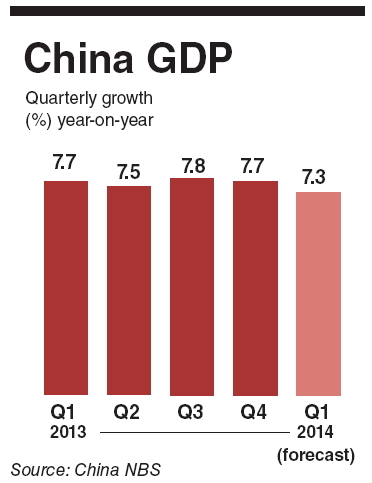China’s loss of economic momentum in the first quarter was deeper than the most widely-cited data will show, according to analyst forecasts for a gauge that’s gaining increasing recognition.
Gross domestic product grew 1.5 percent from the previous three months, according to the median estimate in a Bloomberg News survey ahead of data released Wednesday, down from 1.8 percent in the fourth quarter. That indicates a sharper deceleration than the median projection for 7.3 percent growth from a year earlier, down from 7.7 percent.

Investors are focused on the scale of a slowdown that prompted Premier Li Keqiang to provide what some analysts dubbed a “mini-stimulus” of spending and tax relief. While the indicator suffers from flaws including the government’s failure to give details of methodology, it provides an extra tool to analyze an economy that bond-fund manager Bill Gross calls the “mystery meat” of emerging markets.
“The quarter-on-quarter data will show growth momentum has actually bottomed out in the first quarter,” said Chen Xingdong, Beijing-based chief China economist at BNP Paribas SA, who previously worked at the World Bank. The measure “has clearly captured the changes in growth momentum,” Chen said.
Data Tuesday from the People’s Bank of China showed the nation’s broadest measure of new credit fell 19 percent from a year earlier and money supply grew at the slowest pace since 2001, underscoring risks of a deeper slowdown as the government tries to curb financial dangers.
While yuan forwards declined Monday to the lowest level in eight months on concern growth is faltering, economists are picking a rebound this quarter, forecasting quarter-on-quarter expansion of 1.8 percent, according to a separate Bloomberg monthly survey in March. The State Council on April 2 outlined spending on railways and housing, along with tax relief, with annual expansion at risk of missing the 7.5 percent goal. (Bloomberg)
Gross domestic product grew 1.5 percent from the previous three months, according to the median estimate in a Bloomberg News survey ahead of data released Wednesday, down from 1.8 percent in the fourth quarter. That indicates a sharper deceleration than the median projection for 7.3 percent growth from a year earlier, down from 7.7 percent.

Investors are focused on the scale of a slowdown that prompted Premier Li Keqiang to provide what some analysts dubbed a “mini-stimulus” of spending and tax relief. While the indicator suffers from flaws including the government’s failure to give details of methodology, it provides an extra tool to analyze an economy that bond-fund manager Bill Gross calls the “mystery meat” of emerging markets.
“The quarter-on-quarter data will show growth momentum has actually bottomed out in the first quarter,” said Chen Xingdong, Beijing-based chief China economist at BNP Paribas SA, who previously worked at the World Bank. The measure “has clearly captured the changes in growth momentum,” Chen said.
Data Tuesday from the People’s Bank of China showed the nation’s broadest measure of new credit fell 19 percent from a year earlier and money supply grew at the slowest pace since 2001, underscoring risks of a deeper slowdown as the government tries to curb financial dangers.
While yuan forwards declined Monday to the lowest level in eight months on concern growth is faltering, economists are picking a rebound this quarter, forecasting quarter-on-quarter expansion of 1.8 percent, according to a separate Bloomberg monthly survey in March. The State Council on April 2 outlined spending on railways and housing, along with tax relief, with annual expansion at risk of missing the 7.5 percent goal. (Bloomberg)
-
Articles by Korea Herald











![[Hello India] Hyundai Motor vows to boost 'clean mobility' in India](http://res.heraldm.com/phpwas/restmb_idxmake.php?idx=644&simg=/content/image/2024/04/25/20240425050672_0.jpg&u=)








